|
THE END for V-2
troops of Division z.V. (Division for
Retaliation) came in April of 1945. Everywhere in
the Germany the fires were burning. It was a signal
of the incessant and unstoppable penetration by
enemy forces from the east and west. Berlin had been
surrounded for days, yet somehow the German war
effort continued—even as the Allies rolled across
Germany. The retreating Germans formed up to fight
against the Allies, having been rallied by fanatical
commanders still sworn to Hitler. However, in the
end, the soldiers submitted to the overwhelming
Allied supremacy, usually without much resistance.
Hitler had ordered a
breakthrough to rescue Berlin from the Russians
who were squeezing the city. When the orders were
given this plan was already an illusion. The
orders received by the German commanders were
impossible to carry out, as it was no longer
possible to amass effective combat-ready troops.
Tasked with this was the German 12th Army under
General Walther Wenck. Wenck's forces were
piecemealed together using the scattered remains
of broken regiments and divisions—including the
V-2 Division.
On the evening of March 23,
1945, British troops under Montgomery had reached
the Rhine River, and several days later, the
situation for the V-2 troops in Holland became
critical. The German High Command ordered the
immediate withdrawal of all troops and material
related to both the V-1 and V-2 operations in
Holland. Battalion 485 (Art. Reg. 902). Protected
by low clouds on the rainy Thursday afternoon,
they drove in a long procession to Leiden, from
there to Utrecht, and then finally to the German
border. Equipment removed from the firing sites
was littered along the route as fuel ran out and
chain of command broke down. They arrived in the
area of Fallingbostel on April 1, 1945, and were
joined there the following day by the second
battery. A few days later, the majority of the
battalion’s specialized vehicles and equipment,
along with some remaining rockets, were destroyed
haphazardly with explosives at a large outdoor
storage area for V-2s near Leese, northwest of
Hannover in the Hahnenberg Forest.
 The SS Werfer Battery 500
had been firing on Antwerp from sites near
Hellendoorn in Holland. During the last days of
March, some of the platoons were given a quick
course in close-combat infantry training. Being
completely cut off from outside news, the soldiers
could only guess as to why this training was
given. On the nights of March 27–30, the whole
battery packed up and withdrew from Hellendoorn
because of advancing Canadian forces. Each platoon
left the launching area on different nights using
different routes, but all went in the general
direction of Nordrhein-Westfalen. They took
everything, including excess rockets and all
battery vehicles, moving under the cover of
darkness. As the units traveled through Lingen,
Niederdorf, Lemke, and Nienburg, the firing crews
thought it was a normal firing position change.
The soldiers would only find out days later that
the SS 500 had been ordered to move east in
defense of Berlin. On April 1, some of the
platoons arrived at Dorfmark just north of
Fallingbostel, 23 miles north of Hannover.
In the area of
Fallingbostel the men of the SS 500 were split up
into new groups. Some received new combat
assignments, while most formed the nucleus of
several new Nebelwerfer artillery batteries. The
15-centimeter Nebelwerfer 41, or Screaming Mimi as
American soldiers called it, was an artillery
piece that fired solid-fuel rocket projectiles.
The weapon was designed to saturate a target with
spin-stabilized smoke, explosive, or gas rockets.
A large portion of SS 500 soldiers chosen for the
new batteries was previously trained as artillery
men prior to their V-2 deployment. The artillery
pieces were brought in from the Nebelwerferschule
(Nebelwerfer School) at Celle, and a quick
training program was instigated by elements of the
SS Werfer-Lehrabteilung. On April 5, most of the
specialized V-2 equipment and vehicles belonging
to the SS 500 were demolished to prevent their
capture by the Allies. However, the
Feuerleitpanzer halftracks belonging to the
platoons were converted into combat vehicles by
cutting the armored top section away and fitting
them with twin 20-millimeter guns.
At the beginning of April,
Training and Experimental Battery 444 had driven
to Lüneburg Heath and the last few test firings
took place on April 5. On April 10 Battery 444
arrived at the village Steinhorst where a portion
of their equipment was demolished. About nine days
latter half the troop went Welmbüttel in
Schleswig-Holstein, those that remained were later
taken prisoner by the British at or near
Steinhorst. Some of the 444 men formed up with
orders to join the V-2 Division and fight the
Allies as infantry. On May 1 part of 444 men at
Welmbüttel were ordered to join a anti-aircraft
regiment and were then used as infantry soldiers
against the British at Bargteheide/Trittau. On the
same day yet another portion of the 444 were used
as an infantry unit to hold back the British as an
infantry unit. The remaining troops at Welmbüttel
destroyed all equipment and important
documents—rockets and specialized vehicles, such
as the Meillerwagen, were towed into the bog at
Welmbüttel and demolished with explosives.The 444
war diaries were burned (this is why so little
information exists about this unit today). Some of
the soldiers took quarter in nearby villages and
reportedly stayed there until the war ended.
Battalion 836 (Art. Reg.
901) had been idle for several weeks. Having
launched their last rocket from the Hachenburg
area on March 16, 1945, they spent the last days
of the month packing and shipping excess rockets
and equipment out of Hachenburg because of the
lack of liquid oxygen and the Allied breakthrough
at Remagen. They received word to gather at
Bramsche, about ten miles west of Osnabruck, for
further orders. The deterioration of the basic
military situation, however, prevented this.
Instead, the battalion was ordered to the area of
Visselhövede for the Blucher Undertaking. From
there, their remaining rockets were to be fired
against the Küstrin Fortress in Poland. Over the
previous two weeks, Stalin’s forces had advanced
roughly 100 miles from the Baltic, near Kolberg in
Pomerania, to the Oder fortress of Küstrin, about
60 miles northeast of Berlin. The plan fell apart
because of the total breakdown in Germany. On
April 3, 1945, Hitler ordered that no more
explosives were to be used for V-2 warheads, thus
terminating the offensive once and for all. As a
result, all of Group South’s equipment was
destroyed on April 7, 1945, in the area of Celle
to prevent its capture by the Allies.
On April 6, 1945, as the
British forces approached the Weser River, chaos
was everywhere. The German units were disorganized
and communications were nonexistent. Near
Stolzenau some of the excess SS 500 personnel,
along with a battalion of Hitler Youth and a
company of inexperienced German engineers, were
ordered to fend off enemy tanks with only
small-arms fire and a few 88-millimeter flak guns.
Tanks of the British Second Army attempting to
cross the river were eventually turned back but
crossed later at Petershagen, south of Stolzenau.
The tanks headed north to meet up with a British
commando brigade near Leese, where on April 8,
abandoned and demolished V-2s were discovered on
flatbed railcars and in the forest just outside a
chemical manufacturing plant. Kampfstoffabrik
Leese was one of a number of secret plants built
in this area of to produce chemicals for the
German war effort.
Since February of 1945,
there had been a plan by Gruppenführer Hans
Kammler to convert the V-2 launching units into a
normal motorized combat division. Many officers in
the division thought this would be a senseless
waste of human lives. Many recognized the final
defeat for Germany was inevitable and saw the only
sensible solution as being an organized surrender.
On March 10, several division officers, including
Colonel Thom, conducted a meeting at Bad-Essen.
They all agreed the division should surrender and
only sympathetic colleagues should be informed of
the plan. Colonel Thom, Chief of Staff for
Division z.V., blocked Kammler’s ordered
conversion by simply delaying the reorganization
of troops for the required battle groups.
It was understood among all
that the idea of surrender should not be mentioned
to SS General Kammler. It would have been suicide
to do so. Kammler’s fanatical attitude could not
be reasoned with, and any suggestion of surrender
would bring an immediate death sentence. Kammler
had already given the formal order to reorganize
the rocket troops into infantry regiments, and a
few weeks afterward, he made a speech before the
regimental and battalion commanders, giving wild
battle orders. Soon after that, Kammler
disappeared from Division z.V. affairs altogether.
Colonel Thom reasoned that if the division
surrendered as a whole, the Allies might be
interested in employing some of the highly trained
V-2 specialists with their practical field
experience for development of rockets of their
own. He believed, correctly, the Americans and the
British would not want the German rocket troops to
fall into Russian hands. Thom was then called back
to Berlin at the end of March. It is unknown if
his confidence was betrayed after he sought
support from higher echelons in Berlin, but for
whatever reason, he was relieved of his post. It
looked as if the surrender to the Western Allies
might not happen.
On April 10, British forces
discovered several V-2s on railway wagons when
they captured a large munitions factory eight
miles southwest of Nienburg near Liebenau. As the
Allied push from the west drew closer, the
leftover remnants of the SS 500 began a disorderly
retreat to the area near Göhrde on the west side
of the Elbe. In the following days, Battalion 836
(Art. Reg. 901) moved to the marshaling areas east
of the Elbe River where they were joined with
Battalion 485 (Art. Reg. 902) and a portion of
Battery 444 near the area of Dannenberg. The V-2
Division, which converted into a Panzer Grenadier
Division, was now at the disposal of the German
41st Panzer Corps under Lieutenant General Rudolf
Holste (Panzerkorps Holste).
The individual soldiers of
the rocket batteries believed their V-2 mission to
be an important one. They were disheartened by the
rapid retreat and sudden change in their
situation. The war diary of the Battalion 836
(Art. Reg. 901) stated on April 8, “With all of
our specialized equipment destroyed, the
long-range rocket group has lost its character as
an elite unit. Time is up for Gruppe Süd and the
employment of the V-2. We are now nothing more
than an ordinary infantry combat group.”
On April 10 General Walther
Wenck was made the commander of the German 12th
Army located to the west of Berlin. The 12th Army
was positioned to defend against the advancing
American and British forces on the Western Front.
But, as both the Western Front moved eastwards and
the Eastern Front moved westwards, the German
armies making up both fronts backed towards each
other. As a result, the area of control of Wenck's
army to his rear and east of the Elbe River had
become a vast refugee camp for German civilians
fleeing the path of the approaching Soviet forces.
Near Berlin the Soviet
forces of Marshal Georgy Zhukov's 1st Belorussian
Front were encircling the city from the north. The
forces of Soviet Marshal Ivan Konev's 1st
Ukrainian Front were encircling Berlin from the
south. On April 21 German dictator Adolf Hitler
ordered SS-General Felix Steiner to attack the
Soviets and drive to Berlin. Steiner declined to
attack. With few operational tanks and roughly a
division's worth of infantry, Steiner chose the
lives of his remaining men over the lives of the
German leadershp. Instead, Steiner requested that
his army be allowed to retreat to avoid its own
encirclement and annihilation.
On April 22 the V-2
Division and the 41st Corps was subordinated to
the command of General Wenck. As Army Detachment
Steiner retreated, Wenck's 12th Army became
Hitler's last hope to save Berlin. Wenck was
ordered to disengage the Americans to his west
and, attacking to the east, link up with the 9th
Army of Colonel General Theodor Busse. Together,
they were to attack the Soviets encircling Berlin
from the west and from the south. Meanwhile, the
41st Panzer Corps under Holste would attack the
Soviets from the north. Unfortunately for the
Germans in Berlin, much of Holste's forces
consisted of transfers from Steiner's depleted
units.
The makeup of the 12th Army
troops and equipment was to include remnants of
various divisions. A portion was Division Hake
(without communications and only with small arms),
which consisted of two regiments; Infantry Reg.
von Hake 1 (under Lieutenant Colonel Jochim Bahr)
and Infantry Reg. von Hake 2 (under Lieutenant
Colonel von dem Bottlemberg). Another regiment was
formed using remaining personnel from the 1st
Battalion of Flakabteilung from Hannover, a
replacement battalion from Stendal, along with the
communication and service dog training personnel
from Rathenow. A portion of the 199th Infantry
Division was to come from Oslo, but up until April
29-30 only one regiment of the 199th had reached
the planned employment area. Other forces included
2,500 young boys of the 1st Tank Destroyer Brigade
(Hitler Youth) on bicycles armed with Panzerfäust;
the Tank Hunter Brigade “Hermann Göring;” 39th
Panzer Division reserves from Hamburg; as well as
remainder of the armored division “Clausewitz.”
Much of the equipment and heavy weapons for these
troops were now missing.
Also added to the mix of
12th Army units were the 6,000 men of the V-2
Division. The motorized V-2 Division was
considered to be well-equipped even though its
members may not have thought so. 12th Army
commanders were unsure of this "secret unit" and
did not know for sure when the V-2 Division would
arrive in the employment area.
Wenck's army made a sudden
turn around and, in the general confusion,
surprised the Russians surrounding the German
capital with an unexpected attack on April 24.
Wenck's forces attacked towards Berlin and made
some initial progress, but they were halted
outside of Potsdam by strong Soviet resistance.
Neither Busse or Holste made much progress towards
Berlin. By the end of the day on April 27 the
Soviet forces encircling Berlin linked up again
and the forces inside Berlin were completely cut
off from the rest of Germany.
By the middle of April, the
V-2 Division crossed to the east side of the Elbe
River near the town of Dömitz. As part of a
motorized division, they were assembled in the
area of Lenzen, ready for deployment against the
Russians. The unit was then positioned in the area
northwest of Fehrbellin, northwest of Berlin, east
of the Elbe River. Years earlier, this had been
the battleground where one of the most crucial
victories in Brandenburg history had been
achieved. But in 1945, it was the place of a
desperate struggle, which saw the end of greater
Germany. On April 26, 1945, the acting commander
of the division, Lieutenant Colonel Schulz, former
commanding officer of Group North, was persuaded
by SS Lieutenant Colonel Wolfgang Wetzling to sign
an order issuing authority to open surrender talks
with the Americans. Before this could occur, once
again the division found itself with a new
commander when Schulz was relieved by the young
Colonel von Gaudecker.
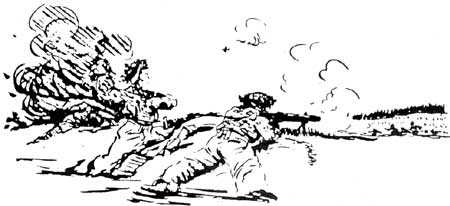
Colonel Wetzling did not
give up. He discussed the surrender plan with
several staff officers of the division. One of
them, Major Matheis, agreed to go with Wetzling to
see the new commander of the division. During a
short meeting on April 29, Colonel von Gaudecker
agreed to the surrender. The plan was discussed in
detail with the wishes of the division written
down. Wetzling and Matheis would act as emissaries
accompanied by a signals officer, and the
arrangements would be transmitted back from the
Americans on a special wireless wavelength. On the
night of April 29–30, von Gaudecker gave two
signed papers, one in German and one in English,
to Wetzling and Matheis. They received an order
for fictitious duty in the area of Lenzen in case
they were stopped by German security patrols. The
three men started off into the darkness to find
the Americans.
The next afternoon, they
reached the banks of the Elbe River, close to the
small village of Wootz. Despite carrying a large
white flag, they were met with mortar fire. Major
Matheis was slightly injured by shrapnel. After
continued shouting and waving of the flag, they
finally got the attention of some American
soldiers on the other side. Several hours later,
the Americans transported the emissaries across
the river and brought them to the local American
headquarters. Later they were blindfolded and
taken to another headquarters. There, talks began
between the German emissaries and 15 officers of
the U.S. 29th Infantry Division. American Colonel
McDaniel presided over the talks and told the
Germans he was authorized to receive their
declarations.
Colonel Wetzling
announced the readiness of the V-2 Division
to surrender en masse, unconditionally,
provided an assurance was given that members
of the division would not be handed over
against their will to the Russians. McDaniel
replied that the unconditional surrender of
the entire V-2 troops was accepted and that
the members of the division would be treated
according to the Geneva Conventions. He was,
however, not entitled to give further
assurances. The emissaries further declared
that the V-2 Division would also bring with
their surrender the goodwill to cooperate in
the further development of the rocket for
the good of the Western Allies. Colonel
McDaniel agreed that the surrender of the
V-2 Division would be kept secret to prevent
reprisals against the families of the
division’s officers. The declaration was
accepted by the Americans and forwarded on
to the higher American authorities.
Colonel McDaniel said
the division should cross at the same point
near Wootz. Boats of all kinds, including
DUKWs (amphibious trucks), would be in
position by the morning of May 1 to ferry
the division across the Elbe. It was not
known how long it would take for the V-2
Division to arrive, but the Germans were
instructed to assemble near Lenzen and to
move from there in a line with every tenth
vehicle carrying a white flag. At the
crossing point, four white flags were to be
erected 50 meters apart from each other. The
Germans were assured that their movements
would be safe from American fighter
aircraft. Colonel McDaniel asked for all of
the V-2 equipment, special vehicles, and V-2
documents of any kind to be handed over to
the Americans. The Germans stated that all
equipment of this kind was destroyed when
the V-2 troops retreated from the
operational launching sites.
|
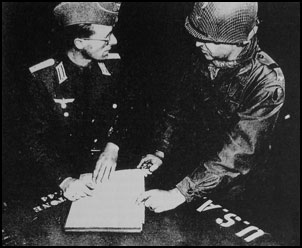
Surrender on the night
of 30 April 1945
|
Without any sleep, Wetzling
and Matheis returned to their division
headquarters. They arrived late in the morning to
find new difficulties had arisen. The situation
had deteriorated considerably because of Russian
advances nearby. Colonel von Gaudecker and Major
Schuetze were in the middle of giving tactical
commands to units battling Russian forces. Von
Gaudecker said it was impossible at that time to
withdraw the division from its positions. The
situation became even more chaotic when reports of
a Russian tank breakthrough near Fehrbellin
reached the headquarters. Wetzling and the other
officers convinced Von Gaudecker that the only
solution was to move the division as quickly as
possible to the river crossing point. As Russian
aircraft circled the area, Von Gaudecker quickly
signed an order to the regimental and battalion
commanders instructing all units of the division
to assemble in the area of Lenzen. The units were
to stay intact, and anything pertaining to the V-2
rocket and its components, as well as any
converted special vehicles, should be brought
along.
While negociations were being
conducted, the former rocket soldiers, most of
whom had no formal training as combat infantrymen,
held the line as best they could. There had been
no time for combat training before the soldiers
were thrust into the middle of the fight.
Nonetheless, even without the benefit of coherent
leadership, they succeeded in repelling many
attacks. Each man did his best and the division
managed to hold each section of the line. In the
east the German lines had endured constant Russian
attacks. From the west, advancing American
divisions caused a critical situation and Division
z.V. was challenged from the rear. As the
artillery bursts were falling, an order came from
regimental headquarters that stated—
“All troops should
immediately disengage the opponent and travel to
the area of Lenzen, near the Elbe River. Our
surrender to the western Allies is agreed upon. In
addition, all existing V-2 material and documents
are to be transported and surrendered.”
That evening as vehicle
after vehicle arrived in Lenzen, the battle sounds
were all around the division. Fires were visible
in nearby villages, and the V-2 division was
running out of time. Major Schuetze was in
command, as Colonel Von Gaudecker had traveled to
the 41st Army Corps headquarters to inform them of
his decision to surrender to the Americans; there
he was promptly arrested. Schuetze had not arrived
in Lenzen because of car problems, and absent of
any divisional commander present, none of the
regimental commanders wanted to take
responsibility to order the columns forward to the
Elbe at Wootz. Already security patrols had passed
by and asked about the destination and purpose of
the movement. A fictitious explanation was given
that seemed to justify the move, but it was
evident the patrols were becoming very suspicious.
As night fell, it was clear no movement could take
place before the early morning hours of May 2.
The westward-route on which
the division had been marching was overcrowded
with vehicles, as well as civilian refugees.
Everyone had the same goal—to escape from the
Russians. The stream of humanity grew larger each
hour until it was up to three columns wide at
points. Motor vehicles in one column, horse carts
in the next, with those on bicycles and on foot in
another column. The V-2 Division made up only a
small portion of these flooding masses. All along
the roads Russian fighter aircraft bombed and
strafed the fleeing Germans repeatedly. Some
wondered if they would ever escape to safety. On
the horizon in the east and south large smoke
plumes could be seen rising into the sky. The
Russians were advancing quickly following the
collapse in German resistance. After the V-2
Division passed the town of Perleberg, the Russian
fighter-bomber attacks ended. Subsequently,
American aircraft were flying over the roads
providing protection to the refugees.
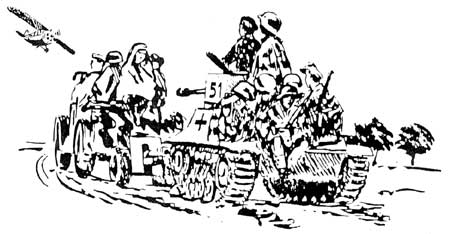
Major Matheis took charge
and ordered the continued advance towards Wootz.
On the morning of May 2, 1945, the first units of
the V-2 Division arrived. Colonel Wetzling was in
the lead vehicle directing the column to the
correct crossing location on the river. American
posts for disarming the surrendering Germans were
set up on the east bank of the Elbe River. The
Americans provided translators to help in
directing the flow, though the crush of people and
vehicles trying to cross the river created chaos.
For awhile, it was everyman for himself. The
troops of the V-2 Division were mixed in with
civilians and other German Army units as the
Americans made sure every transport was filled to
capacity. Storm boats of the U.S. 121st Engineer
Battalion were used to ferry the soldiers, while
the Gorleben Elbe ferry moved the vehicles.
V-2 Division soldiers had
no idea if all of their comrades had made it
across the river. Only a few of the division’s
vehicles were ferried over the river that day, but
more would be brought over later. The ferry
service ended late that evening, around 11:00 PM,
with many refugees remaining on the east bank of
the river. The majority of the rocket soldiers had
successfully crossed the Elbe, but the members of
the division were saddened to learn a few comrades
had been left in the rear. Behind them, the smoke
pyres were subsiding, signaling the Russians were
quickly advancing towards the Elbe. If not for the
efforts of these few division officers such as
Colonel Wetzling, the whole of the V-2 Division
might have been slaughtered or taken into
captivity by the Red Army. Thus, with the capture
of the V-2 Division, the German A-4/V-2 ballistic
missile campaign came to an end. At dawn the next
day, word spread among the V-2 troops of Hitler’s
death, which was announced overnight.
Meanwhile, during the night
of April 28, General Wenck reported to the German
Supreme Army Command in Fuerstenberg that his
Twelfth Army had been forced back along the entire
front. According to Wenck, no attack on Berlin was
now possible. This was even more so as support
from Busse's Ninth Army could no longer be
expected. In the early morning of April 30,
General Jodl sent a message to Krebs: "Wenck's
spearhead bogged down south of Schwielow Lake.
Twelfth Army therefore unable to continue attack
on Berlin. Bulk of Ninth Army surrounded. Holste's
Corps on the defensive."
As his attempt to reach
Berlin started to look impossible, Wenck developed
a plan to move his army towards the Forest of
Halbe. He planned to link up with the remnants of
other German forces to provide an escape route for
as many citizens of Berlin as possible. Despite
the attacks on his escape route, Wenck brought his
own army, remnants of the Ninth Army and many
civilian refugees safely across the Elbe and into
territory occupied by the American Army. Estimates
vary, but it is likely the corridor his forces
opened enabled up to 250,000 refugees, including
up to 25,000 men of the Ninth Army, to escape
towards the west just ahead of the advancing
Soviets.
The V-2 Division's escape
was later looked upon as selfish and possibly even
cowardly to some. The mobility of German 41st
Panzer Corps was severely restricted because of
the lack of motor vehicles—many of which were
taken by V-2 Division during their retreat. One of
the locations where the Russians broke through was
the spot where Division Gaudecker should have
occupied. After April 28 the area was loosely held
by RAD Abteilung 1/91 (Reichs Arbeits Dienst, CT)
and Battallion Mecklenburg of the 1st Panzer
Vernichtungs Brigade Hitlerjugend (Hitler Youth).
On April 30 the area was defended by the
retreating 3rd Marine Infantry Division and units
of the 25th Panzer Grenadier Division. After the
Division Gaudecker left its place in the
frontline, only a small Grenadier regiment of
Division Ulrich von Hutten witheld the Soviets
from breaking through. The 5,000 men of Division
Hutten lost a considerable amount strength because
of casualities.
Of course, given the situation,
the move of the V-2 Division to the Elbe River was
very difficult. Confusion was everywhere, and the
constant threat of air attacks made any movement
extremely difficult. Nevertheless, the majority of
the division made its way to the crossing point in
good order, arriving on the night of May 1-2.
During these last few days, it appears the
remnants of the former SS Werfer Battery 500 were
not among the V-2 troops surrendering at the Elbe.
During the last days in April, most of the former
SS 500 units were cut off by a Russian attack in
the area of Friesack. Assigned to fight with
another German division to the south, the
Nebelwerfer batteries expended most of their
ammunition in skirmishes against Russian forces.
However, some of the fractured SS 500 groups,
instead of joining in the useless fight against
the Russians, intentionally remained “lost” in an
attempt to survive the last days, until they
finally surrendered in small groups at various
locations. Only a few of these men managed to make
it through to the crossing at Wootz.
|
Units of the V-2 Division marched in
perfect order into captivity. Led by their
officers, the men were allowed to carry
only hand baggage and blankets. Further up
the west bank they were again checked for
weapons and a portion of their personal
property was removed before marching again
to a collecting station. The rocket
soldiers queried each other about their
comrades. When a straggler came in, he was
greeted and stories of the terror were
recounted. All were thankful to have
achieved relative security. American
trucks arrived intermittently, beginning
on May 2 and ending on May 4, to transport
the V-2 Division members to the rear. The
roads again were swamped with traffic and
movement was slow at first. After the
Americans ceased to translate for the
Germans, there were rumors circulating
that reported the Russians had demanded
the return of the V-2 Division. Urgency
was needed and the convoy soon raced along
the roads. The trucks were dangerously
close to one another; nevertheless, the
black American truck drivers were experts
at navigating the overpopulated roads and
stopped only once before arriving at Camp
Herford after nightfall.
As
the trucks pulled up and stopped, the
headlights lit up a large field in the
middle of a sports stadium. The American
soldiers then barked commands. The
trucks were emptied and the Germans were
herded like cattle in a line towards the
field. Scattered over the field were
humans of all categories. People of all
ages, all military ranks and
services—even civilians, including women
and girls—were seen huddled in groups.
|
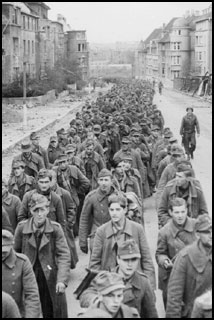
|
Even though it was so
crowded that there was no place to sit, continuous
throngs of prisoners were pushed into the area.
There was nothing to eat or drink and the existing
latrines were in sufficient. The conditions were
abhorrent. After nightfall it was easy to hear the
despair. The lunatic calls echoed into the night.
Spotlights scanning the crowds and machine gun
bursts would wake those fortunate enough to find
sleep. The Military Police used brutality—fists
and batons—to control the crowd. The remaining
property of the captured Germans, such as
compasses and watches, was confiscated.
Divisional Judge Wetzling
began inquiring with American authorities as to
the whereabouts of the members of Division z.V. He
also sought to have the rocket troops removed from
their current circumstances at the camp. Wetzling
was asked by the authorities to locate and select
about 100 V-2 guidance specialists, crews and
technicians, but given the current state of the
division, this was extraordinarily difficult.
Those selected would be removed from the division
for an indefinite period. On May 7, 1945, the
chosen specialists were moved from the masses at
Herford into a nearby public swimming pool. That
evening one of men cooked a magnificent pea soup,
their first warm meal in days. On May 9 the
Germans were placed again on trucks. The men
wondered—what was their destination? Were they
going to America?
The trucks rolled on past
the Dutch border towards Belgium. In many villages
the streets were full of citizens, many still
celebrating V-E Day. As the convoy of trucks drove
through the many towns along the route the Germans
were jeered and pelted with all varieties of
projectiles. Flowerpots, along with beer and wine
bottles, rained down on the men in the trucks. The
worst of this abuse occurred as the convoy passed
through the dense streets of Brussels. As the
drunken crowd screamed their insults, the Germans
remained expressionless. After driving around
Brussels for hours, the convoy finally rolled to a
stop at another camp. This former brickyard was a
British camp and the rocket men wondered if they
were brought to this new location intentionally or
by mistake. They were not given a reason. Over the
next few days the Germans formed together the
basic command structure of their new guidance
group. Made up of the existing men of the former
V-2 battery, the new troop was commanded by its
oldest officer, Lieutenant Colonel Weber, along
with two staff officers and the Divisional Judge.
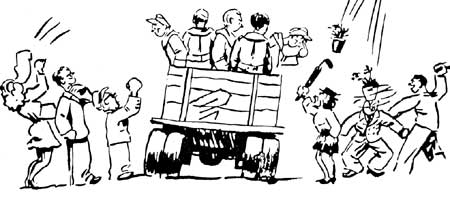
Their stay in Brussels was
short. On May 11, 1945, the Germans were rousted
from their meager accommodations and again packed
onto trucks in the hot midday sun. After driving
west for several hours they arrived at another POW
camp near Brügge. The rocket troops were housed
with the regular prisoners of war, but were not
separated from one another. The long days at
Brügge were very monotonous. The Germans occupied
their time in camp by attending lectures
concerning art, literature and music. The soldiers
attended theatrical plays put together by the
prisoners of the camp. They retained the
impression that the British had no future plans
for them. However, on May 13, 1945, a British
officer arrived at the camp and began asking
technical questions about the V-2. Per his
request, the Germans prepared a memorandum
describing the general overview of the rocket and
its operation. The papers were given to the
officer along with an organizational chart of the
V-2 Division. After British interrogators returned
several more times, the Germans began to realize
that the Allies were greatly interested in the
V-2.
On June 1, 1945, the men
learned that they would be transferred once again
to a new camp. The following morning the men of
the V-2 command were served a large breakfast of
milk and fruits. After formalities, several trucks
arrived to transport the Germans—trucks that were
much more comfortable than the ones previously.
Two days supply of food was brought with them. The
men questioned again, what would be their
destination? There was a rumor of going to
Germany, namely Koblenz. Around noon the convoy
passed again into Brussels. This time the drivers
took a more discreet route and they entered
substantially unimpaired. Near the outskirts of
the city the trucks came to a stop at another POW
camp. The Germans hoped that this would be just a
short stay for food, supply and rest, but they
were soon disappointed. After being ordered from
the trucks, an NCO barked the roll call. Then, as
they marched into the fenced-in internment camp,
the men were shocked to see tattered tents
sprawled in the middle mud covered field. The
dejection felt by the men, who only the day before
had been well situated in the Brügge camp, was
indescribable. As the men received their evening
meal, which was only a thin marmalade soup, they
felt like they were once again being treated as
criminals.
A meeting was called, led
by a British major, who informed the Germans of
British plans to launch V-2 rockets near the
German town of Cuxhaven. A few days later, a
certain British general traveled to the camp to
ascertain the technical abilities of the captured
German rocket troops. The British were also
interested in the specific requirements pertaining
to preparation of a firing position. It was
suggested that the specialists of V-2 Division,
which had all been selected earlier based upon
their technical and field knowledge at the Herford
camp, would be used to conduct the firings while
under British supervision. The Germans offered a
delegation of men to travel to the launch area for
inspection, but this was denied.
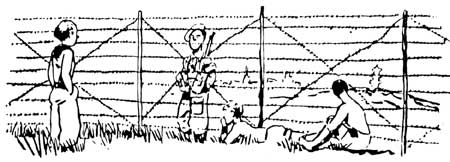
On June 30, 1945, all of
the men were marched from the camp to a transit
store. There was a rushed, but thorough, medical
examination before the Germans were loaded again
onto trucks. The convoy traveled through Antwerp,
into Holland, passing Tilburg and then on to
Arnhem, where the men were given temporary
accommodation for the evening in a Dutch
schoolhouse. When they arrived a rowdy crowd of
Dutch citizens surrounded the trucks, but the
British soldiers of the convoy took control of the
situation and quickly dispersed the crowd. The
next morning they traveled on towards the German
border and crossed at Oldenburg. Near Bremen the
British transport officer had to ask some American
soldiers for directions, but finally they arrived
at Cuxhaven after midnight, and the Germans were
billeted for the night inside an old fishery. On
the morning of July 2, 1945, the Germans were
brought to the British camp nearby at Altenwalde.
The complex of buildings
and shops was all that remained of the former
Krupps gun testing range. After a good cleaning,
the former barracks of the Kriegsmarine provided
friendly and comfortable accommodation,
particularly when compared with the previous camps
in Belgium. In the surrounding sheds they found
some badly demolished tools and equipment which
had belonged to the previous facility. The Germans
had already been told of the plans to refurbish
the shops and equipment in preparation for the
upcoming British tests, but it was certainly
clear—new procurement would have to come before
any visible work could be carried out. With great
difficulties, Major Matheis organized the
operating administration of the V-2 troops. There
was literally nothing available to them. Only a
few pencils existed and the men were forced to
create their own rulers and compasses.
However, the
Germans wanted to begin quickly, thinking
the sooner they conclude their tasks, the
sooner they might be released to check on
their families. Using the former jargon of
the wartime operational batteries, the
group took the name Versuchskommando
Altenwalde (AVKO). The group is commanded
by German Lieutenant Colonel Weber, former
commander of Artillery Regiment
(motorized) 901 (Battalion 836), Division
z.V., Group South.
The name of the British project is given
as Operation Backfire. The V-2 men were
supplemented by necessary numerous
auxiliary workers who came over from the
736th Labor Camp. At the end of July the
command was substantially expanded with
the addition of a large number of
civilians. AVKO had requested numerous
scientists and skilled workers from
Peenemünde and the Mittelwerk to
supplement the existing workforce.
Director
Lindenberg and Professor Wierer headed
the technical shops, while Arthur
Rudolph directed the manufacturing
department. All departments were under
the supervision of the British Technical
Team, a group of chosen experts in key
fields of expertise. Eventually, an
almost identical arrangement was
achieved, which mirrored the wartime
technical, manufacturing, and
operational procedures. Difficulties
between the shops were worked out
quickly, as the Germans realized the
necessity of reaching the common goal.
|
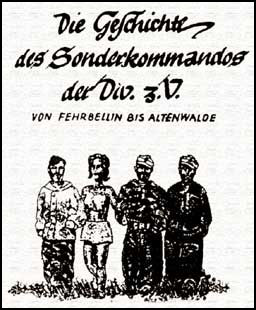
|
When the members of the V-2
Division arrived in Altenwalde they came as POWs.
But on July 20, 1945, the kommando received the
status of “Disarmed German Personnel” and were
subordinated to the instruction of their own
commanders. They were allowed to move about freely
and received military pay from the British for
their services, with extra pay promised on the
completion of their work at Cuxhaven. Even though
their work had begun under the poorest of
conditions, it wasn’t long before conditions
improved. A spacious assembly shop and an
impressive testing tower were just a few of the
improvements built by Royal Engineers. New
concrete roads were constructed with extensive
work near the actual firing position, which is
situated in the forest just offshore. At this
location large concrete bunkers for firing control
and observation are also built.
Each day at 5:00 PM, after
a rigorous day of work, the siren announced the
end of the shift. The men flowed out of the
offices and shops and walked the road to their
quarters. The camp became “home.” This sentiment
was reinforced in those who were allowed to travel
on official business to other areas of war-ravaged
Germany. At Altenwalde, a place untouched by the
storm of war, they felt a sense of community. In
September the work of the Germans was coming to a
conclusion with a total eight V-2 rockets being
produced. The date of the first firing was
announced as September 27, 1945. A nervous tension
was felt experienced by everyone as the day
approached. The first rocket was towed to the
firing position a few days prior to launching. It
was under a storage tent and protected by a
British special guard.
Beginning a few days late,
the first rocket was finally ready. October 1,
1945, dawned with gray skies and increased tension
in the camp. Everyone questioned whether of not
the launch would occur this day. The English
officers express their doubts, but an attempt was
mounted anyway. The results were not satisfactory.
After two failed ignition attempts, the rocket had
to be defueled. However, in the face of this the
German firing crews were not discouraged. Many
delays such as this had been experienced by the
firing crews during wartime operations;
nonetheless, some of the British officers
condemned the device as too complicated.
October 2, 1945, presented
a fair day with sunny skies. Confidence was high
and the launch went off perfectly. The rocket was
seen rising into the blue sky all the way through
Brennschluss. Rejoicing and emotional release
swept through the German command. This was matched
by the enthusiasm of the British soldiers. Sincere
words of the acknowledgment were given to the V-2
Division soldiers.
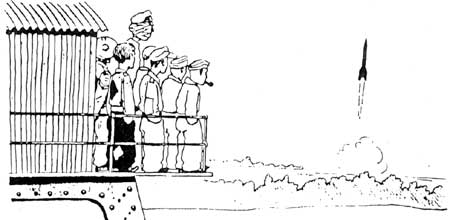
During the summer of 1945
British authorities first anticipated that at
least thirty V-2 rockets would be assembled for
the Backfire tests near Cuxhaven in Germany.
However, because of scarcity of materials, only
eight rockets were assembled, and of these, only
three were launched. If one can believe the rumors
that were circulating in July of 1945, more than
200 V-2 rockets were transported to Altenwalde and
the excess material was sunk in the bay at the
conclusion of the tests, but documents confirming
this have not been found so far. At the conclusion
of the tests the former men of the V-2 Division
filtered back into German society to begin new
lives.
A number of years later,
although claiming his innocence, Wolfgang Wetzling was convicted of war
crimes for complicity in the executions of foreign
laborers near Warstein in March of 1945.
|

